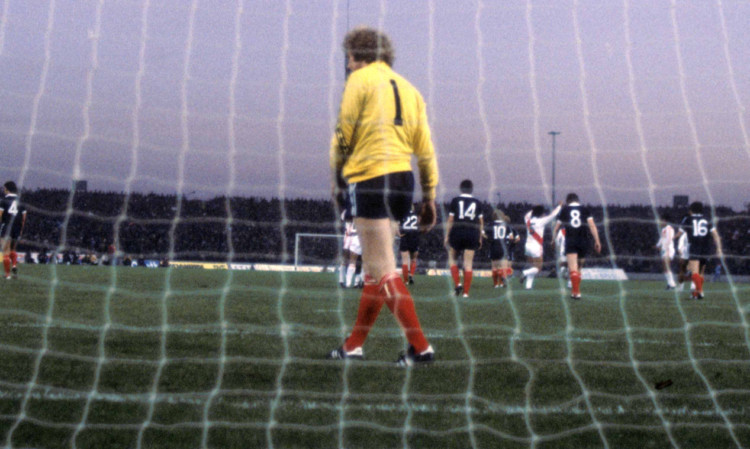In Scotland, you only need to mention one country and one year if you want to send football fans of a certain age into a cold sweat.
I refer, of course, to Argentina 1978.
The beautiful game showed its ugly side back then as Ally McLeod’s team so packed full of talent failed so spectacularly in South America.
Those adventurous but skint members of the Tartan Army who made it to those World Cup finals screamed: “We want our money back!”
Those who stayed at home shouted at their TVs. Manager Ally McLeod just sat in his dugout with his head in his hands.
It all started so promisingly in the first group game as Joe Jordan gave the Scots the lead against Peru.
Then came three goals for the opposition the name of one of the scorers Teofilo Cubillas still sends a shiver up and down the spine and a nation was left dazed and confused.
Even the gift of an own goal from Iran in the next match wasn’t enough to help Scotland to victory, Oh no, we had to lose a daft equaliser.
The defeat to the Peruvians and draw against the Iranians meant that the players could now do what Scotland have been expert at in World Cups exit the competition in style.
Needing to win by three clear goals against Holland the best footballing side at that World Cup who would go on to lose to the host country in the final McLeod’s men conceded a penalty goal to the Dutch after half an hour.
The cause looked totally lost but Kenny Dalglish levelled just before the break and Archie Gemmill scored a spot-kick just a minute after the interval to put the Scots 2-1 ahead.
They still needed another couple but Gemmill then conjured up the most magical goal ever scored by Scotland, dancing through the Dutch defence to make it 3-1 on 68 minutes.
Sadly, the tantalising prospect of progress was snatched away just three minutes later when the brilliant Johnny Rep fired home from 25 yards to make it 3-2 and that’s how it stayed.
The failed drug test for winger Willie Johnston only helped pile on the agony and that is the lowest the Scots have sunk in World Cup terms.
Each country has their own tale of woe to tell, though.
For example, England’s semi-final penalty shoot-out defeat to West Germany at Italia 90 will probably never be erased from the collective memory down south.
The French can rightly moan about the ludicrous assault on Patrick Battiston by West German goalkeeper Harald Schumacher in the 1982 semi that probably robbed them of the cup in Spain, while many Germans will still feel that Geoff Hurst’s shot didn’t cross the line in 1966…and they may find some support for that argument in these parts.
However, the biggest shock felt by any nation at any World Cup has to be that suffered by Brazil in 1950.
It was the game that is still known as the greatest catastrophe in the history of Brazilian football, when the host nation lost 2-1 to Uruguay at the Maracana in Rio de Janeiro.
It wasn’t a final as such because of the way the competition was structured, which was in a league set-up, but it was still a decider.
Brazil needed a draw to be world champions for the first time, while their opponents had to win.
The hosts took the lead after just two minutes of the second half through Friaca and a mass of handkerchiefs and scarves filled the air.
On 66 minutes, however, the packed stadium fell silent as Uruguay equalised with a well-worked move finished off by Juan Alberto Schiaffino.
To the horror of those present and watching and listening at home, it was 2-1 on 79 minutes as the Uruguayans struck once more through Alcides Ghiggia.
The Brazilians tried all they could to get one back but failed with each foray forward.
At the full-time whistle, all but a few hundred of the 174,000 crowd joined the rest of the country to weep in unison.
Newspapers at the time wrote that “stadium doctors treated 169 people for fits of hysteria and other troubles. Six were taken to hospital seriously ill”.
There was even a word invented to describe that day Maracanazo and as a direct result of the defeat the national team changed for all time from the white shirts worn in that final to the world famous yellow and green tops.
Brazilian anthropologist Roberto daMatta described that final as “perhaps the greatest tragedy in contemporary Brazilian history because it happened collectively and brought a united vision of the loss of a historic opportunity”.
So as we progress through this competition, Brazil’s players will carry both the weight of expectation and history on their shoulders.
It could prove to be too much of burden. Is it possible that anything could be worse for the Brazilans than that Uruguay defeat?
Well, if their greatest rivals Argentina, led by the globe’s best player Lionel Messi, were to win the World Cup in Rio on July 13 then the answer is a resounding yes.
